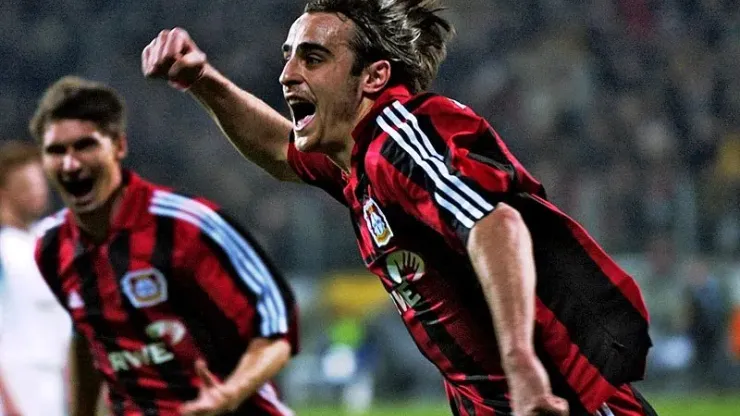Bayer Leverkusen (4-1-4-1): Butt, Sebescen, Nowotny, Lucio, Placente, Ramelow, Schneider, Basturk, Ballack, Ze Roberto, Neuville.
For a team of so much quality, this Leverkusen side ended the 2001-2002 season without a trophy. They completed the treble of second-place finishes, losing to Real Madrid in the Champions League final, losing the German Cup final to Schalke, and losing the league title on the last day of the season. Due to these failures, many labeled this side as “Bayer Neverkusen”, yet despite the ultimate lack of success, this side did very well throughout the season. This Leverkusen side put on a brilliant Champions League run, defeating Arsenal, Liverpool and Manchester United in successive rounds to reach the final. The lineup contained some great players, including Lucio, Ze Roberto and Michael Ballack.
Leverkusen’s manager, Klaus Topmoller did a fantastic job at the club, employing a 4-1-4-1 formation in the 01-02 season. Up front, Oliver Neuville did a superb job. At the time when many sides played with two strikers up front (one target man and one second striker making runs), or a lone target man, Neuville managed to do well despite his lack of height. At 170cm, his movement drew defenders out of position, opening space for the runs of the oncoming midfielders. Michael Ballack benefited from this, as he scored 17 goals in 29 league games and seven in 15 Champions League games. Alongside Ballack in midfield was Yildiray Basturk, who sat and composed play with intelligent passing whilst also going forward. The two wingers, Bernd Schneider and especially Ze Roberto, crossed from wide positions and tracked back to cover Diego Placente and Zoltan Sebescen respectively. The defensive midfielder in the side, Carsten Ramelow played more as an extra center-back or sweeper. He, in truth, was a tall center-back, and played just ahead of Lucio and Jens Nowotny at center-back. Ramelov often dropped deep alongside the center-backs, forming a three-man defense. This allowed the fullbacks Placente and Sebescen freedom to go forward. Also, if only one of the two fullbacks was forward, the fullback on the opposite side could tuck in to form a four-man defense to keep the side organized.
In the end, Leverkusen lost the Champions League final to arguably the most memorable goal in the competition’s history – Zinedine Zidane’s left-footed volley. In the run-in to the final, captain Nowotny suffered a knee injury, missing the final, as did Ze Roberto. Despite Ballack’s heroics, the side were still rather balanced in their goalscoring. A good example of this is the scoring of penalties. Across the league season, Hans-Jorg Butt (the goalkeeper), Ulf Kirsten, Neuville, Ballack, and Thomas Meggle all scored penalties. Apart from Ballack’s goals, both Neuville and Dimitar Berbatov scored goals to lead the charge. Overall, this side displayed many characteristics often seen in soccer today. A not-so-tall forward playing up front as a lone striker, players making forward runs from midfield to score goals, fullbacks pushing forward, and a defensive midfielder who had no purpose to go forward, but instead to cover the center-backs.
Sadly for this Leverkusen side, both Ballack and Ze Roberto were sold to Bayern Munich in the summer of 2002, and subsequently, the side struggled. They finished 15th in the Bundesliga, barely escaping relegation, and went out of the Champions League in the second group stage, failing to clinch a single point. Despite the failures in the following season which saw Topmoller sacked, this Leverkusen side were a team who had never won the Bundesliga in their history and he took them as close to success as possible.
200+ Channels With Sports & News
- Starting price: $33/mo. for fubo Latino Package
- Watch Premier League, Women’s World Cup, Euro 2024 & Gold Cup
The New Home of MLS
- Price: $14.99/mo. for MLS Season Pass
- Watch every MLS game including playoffs & Leagues Cup
Many Sports & ESPN Originals
- Price: $10.99/mo. (or get ESPN+, Hulu & Disney+ for $14.99/mo.)
- Features Bundesliga, LaLiga, Championship, & FA Cup
2,000+ soccer games per year
- Price: $5.99/mo
- Features Champions League, Serie A, Europa League & Brasileirāo
175 Premier League Games & PL TV
- Starting price: $5.99/mo. for Peacock Premium
- Watch 175 exclusive EPL games per season






